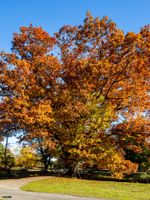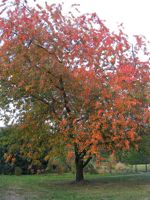Mon-Fri 9am - 5pm Mountain time
Northern Red Oak vs Black Cherry
Quercus rubra
Prunus serotina
NOT AVAILABLE THIS SEASON - MIGHT RETURN
Northern Red Oak is a medium-sized deciduous tree. It is fast-growing (for an oak tree) and is used primarily in lawns, parks, golf courses, street-side plantings, and commercial areas. Northern Red Oak's fall color is spectacular.
In open spaces, it has a short, massive trunk and an extensive crown. In forests Northern Red Oak grows with a tall columnar bole and small rounded head.
We are one of the only nurseries growing this tree.
Check out some video of the spectacular fall colour on our Northern Red Oak seedlings just before harvest on our YouTube Channel.
Note: Most Oak species can be considered toxic for many animals.
Black Cherry is common in eastern North America but a rare find elsewhere. This tree is shade tolerant and is often found in old fields, forest openings, and along fencerows.
The fruit is edible and is commonly used to flavor rum and brandy. It is also edible and often eaten fresh or used in wine or jelly. Black Cherry trees typically begin producing fruit when they are 10 years of age.
Black Cherry wood is a rich reddish-brown color and is strong, making it valued in cabinetry and woodworking. It is often used in reclamation as well.
The leaves can poison livestock as they contain cyanide derivatives and precursors. However, many have noted that deer still seem to browse their trees with impunity and birds and other animals eat the fruit when available.
Northern Red Oak Quick Facts
Black Cherry Quick Facts
Toxicity: bark and wilted leaves toxic to livestock

